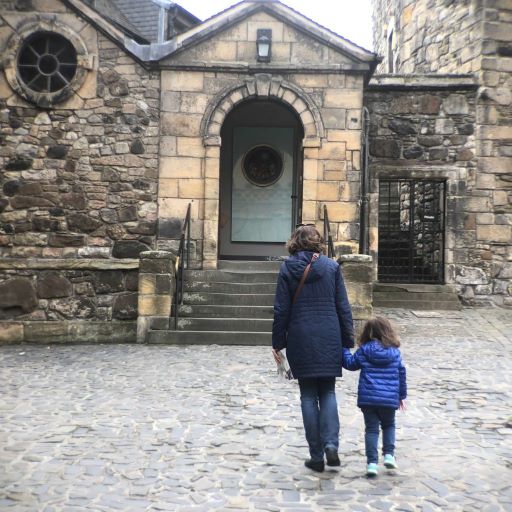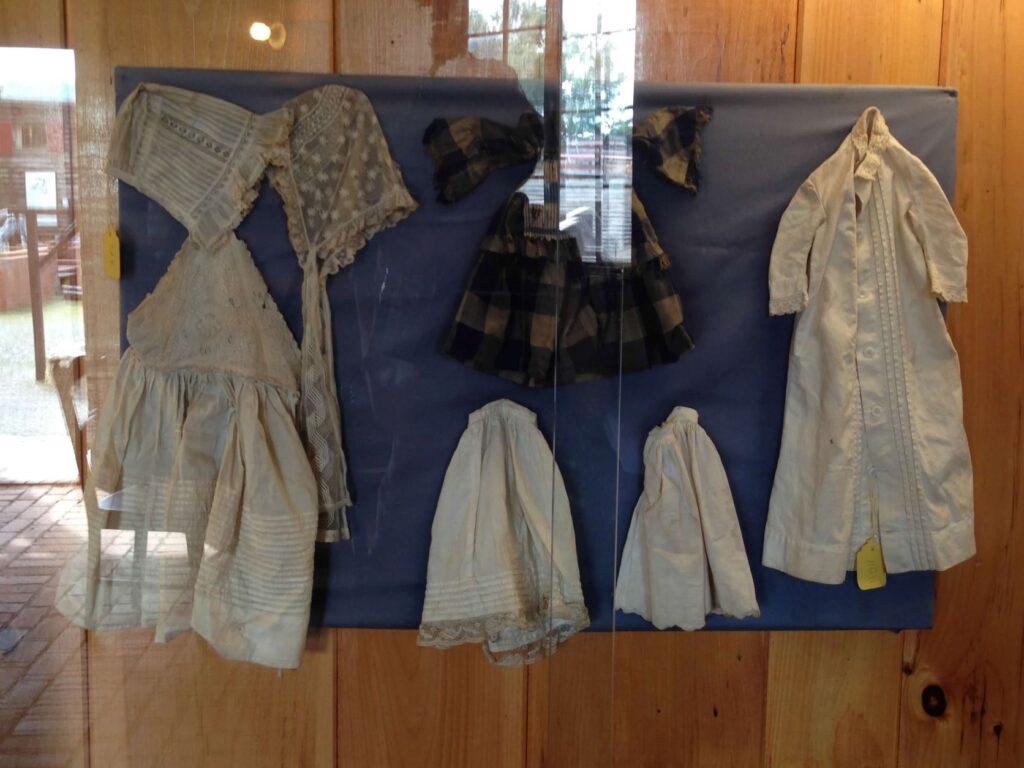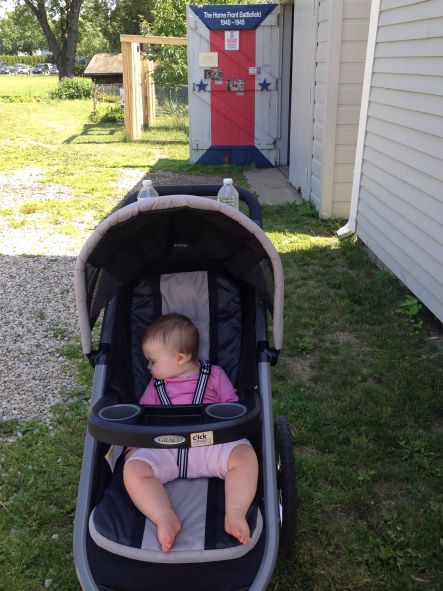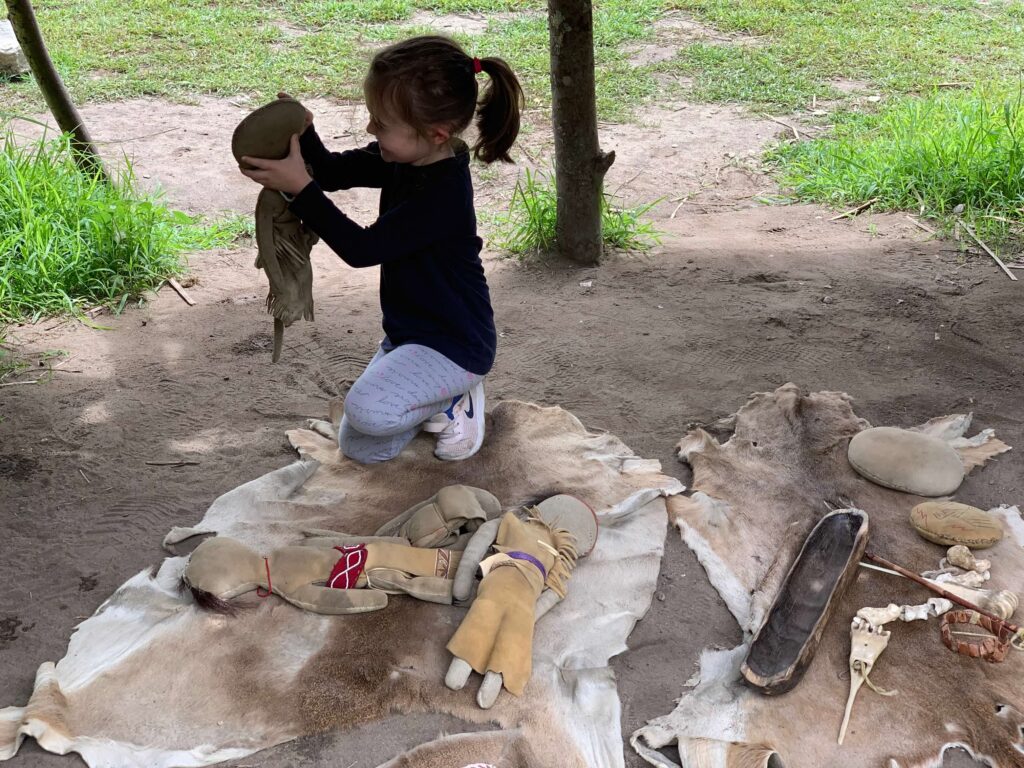Historic sites might seem like an odd choice of places to visit with toddlers, but it has been a part of my life for many years.
My children are six years apart, so I’ve had one toddler or the other in my house for a long time, and both of them started visiting historic sites when they were under a year old.
But just getting out the door with toddlers can be a daunting prospect, so why try to take them back in time, aside from permission to rub whiskey on their gums*?
*100% joking! I have never put whiskey on my children’s gums, nor should you. Proceed with extreme caution whenever you encounter health and safety tips from the past. (I did once get a great teething biscuit recipe from an interpreter at Strawbery Banke in Portsmouth, New Hampshire, though.)
There are a number of reasons to add historic sites to your list of places to visit with toddlers, but my main one has always been that I wanted to go myself. If mama ain’t happy, ain’t nobody happy. Families are made up of people of different ages, and sometimes toddlers just have to go along with the rest of us.
But historic sites also can provide wonderful opportunities for the toddlers themselves. Read on to learn more.

DISCLOSURE: This page may contain affiliate links. This means if you click on a link to a product or service and make a purchase, I may receive a commission at no cost to you. I choose affiliates with care and appreciate your supporting my work in this way. See Disclaimers and Affiliates for more information.
What Does it Mean to Add Historic Sites to Your List of Places to Visit with Toddlers?
Let’s define terms.
I think of a toddler as a person who is “toddling.” They can walk, at least to some extent, but they (or more accurately, you) don’t have a lot of control over their movements or their impulse control. They cannot yet be reasoned with. They touch everything. They get very mad when they don’t get what they want in that minute and they let you and everyone else in the vicinity know it.
If you’re thinking, “Hey, that sounds like some grown-ups I know!” read on. Perhaps these tips will help them too.
For my older child, this phase was roughly one to four. Around five, something clicked and we were able to travel and visit historic sites without making a lot of toddler accommodations. So then we decided it would be a great idea to have another baby and start all over. My younger child is 21 months, so we’ve been in the thick of this for years.
Historic sites can be anything from a small roadside marker to a large multi-site attraction like Colonial Williamsburg in Williamsburg, Virginia, where our family visits often. Whatever the size and wherever the historic site, the information in this post will help you have a successful visit.
Benefits of Putting Historic Sites on Your List of Places to Visit with Toddlers
There are are many benefits for the whole family.
Let’s start with the grown-ups.
You still get to go places. Grown-ups and older children don’t have to put their lives and interests on hold for several years when you can confidently pick up your toddler and take them with you. Sure, you will make accommodations for that younger member of your family, but that is part of the experience of going places as a family.
Also, sometimes it seems to me that a big part of parenting toddlers is just finding ways to keep them busy without driving yourself crazy. The more options you have for activities, the better.
Older children can help the toddler.
This can be an amazing learning experience and confidence building exercise. Plus, it’s historically accurate and developmentally helpful for older children to help care for younger ones (as long as they aren’t given too many responsibilities), but they have that opportunity much less often today. It’s not natural for children to play and learn only with other children of their exact same age, but that’s the case in most school and childcare settings. This gives older children a chance to share what they know and be helpers, while younger children have a model to follow.
Your toddler is learning.
When you add historic sites to your list of places to visit with toddlers, you do so with the knowledge that they’re not learning historical “facts” just yet–but they are learning that your family values history.
They are also learning what historic site visits are like. They are learning through immersion, and one day, as it did with my daughter, it will click, and they will seem like an old pro.
I keep thinking of that old early childhood standard, “What I learn from birth to three is what will matter most to me.” You really never know where experiences in early childhood will lead.
Learning about the past is kind of like learning to speak another language. The earlier you start, the more naturally it will come.
|Related: History Activities at Home: 5 Simple, Fun, and Cheap Ideas
How to Start Adding Historic Sites to Your List of Places to Visit with Toddlers

(Sorry about the glare.)
I recommend starting with a small local historic site. It’s much easier to do a day trip or an excursion of an hour or two than it is to plan an entire family vacation to a huge multiacre site. There are historic sites all over the place, and many have opportunities for toddlers to engage in some sort of sensory play.
My family often visits Fort Hunter Mansion and Park in Harrisburg, Pennsylvania. The children play on the playground and enjoy time in nature. We still haven’t made it inside the mansion, but we’ve done the outdoor self-guided walking tour (with the toddler in the stroller) and learned a lot about Fort Hunter’s history and environment from the interpretive signage and from the experience of observing the buildings, garden, covered bridge, and 40 acres of parkland.
The goal is to lay the foundation. You’re teaching them that history matters, which they will learn simply by being in historic spaces. They will learn history by engaging with it in a multisensory experience, which greatly reduces the risk that one day they will decide history is a boring practice of memorizing dates. They will know otherwise.

My 2 Top Tips for Successfully Adding Historic Sites to Your List of Places to Visit With Toddlers
Know your toddler and know your historic site.
Know when your toddler will need to eat, nap, be changed or go potty, and know ahead of time where you plan to do those things. Set yourself up for success.
My kids have always napped best on the go. Stirling Castle in Stirling, Scotland, is known for many things, but in our family it will always be known as the site of my older child’s Most Epic Nap. She was 21 months old on her first visit and she slept for three hours in her stroller in the shade of the Great Hall, while two parents and two grandparents traded off sitting with her. It remains the longest nap she has ever taken.
Which brings me to my next point…
Work out the best toddler/child/adult ratio you can.
If you’re visiting a small local site, you may be totally fine with bringing your toddler on your own and visiting multiple times to get the full experience. However, if you’re at a bucket list, once-in-a-lifetime place where you and any other adults or older children don’t want to miss anything, do everything in your power to bring at least one other grown-up along. That way you can trade off toddler duty and everyone can have a chance for some independent exploration.
|Related: 8 Fun Fall Activities for History Lovers
Frequently Asked Questions About Visiting Historic Sites With Toddlers

The #1 Reason to Add Historic Sites to Your List of Places to Visit with Toddlers

in Plymouth, Massachusetts
Historic sites are great places to visit with toddlers.
It’s fun.
It’s doable, it’s worth it, and it can be enjoyable and memorable for the toddler and the whole family. Most historic sites love to welcome families and introduce the next generation to their work.
If you’ve visited historic sites with toddlers, what would you add to this guide?
If not, what questions do you still have?
I hope you have a great time visiting historic sites with your family, toddlers included. And please let me know about your adventures!
Pin it for later!

6 comments
Great tip about having enough adults per child! As a history lover, I’m so keen on taking my little guy to these kinds of places but I do fear he will accidentally touch something he’s not supposed to!
Oh, I do hope you will give it a try! Most historic sites really do love to welcome families. It’s unlikely anything really irreplaceable will be available for the public to touch–in historic house museums, for example, many items are reproductions with the actual artifacts under glass or otherwise protected. (Still don’t recommend the house tours for toddlers, though.) The only place I’ve really seen things out that could be damaged by many hands touching them was the Jane Austen Centre in Bath, where they do have some Napoleonic Era uniforms on display with a “don’t touch” sign. Even so, I was surprised to see them within touching distance.
I’ve found sites with outdoor components to be the best for the little ones. If you’re anywhere near Upper Canada Village, I highly recommend it. We took my daughter when she was three and had a lovely time.
When traveling with children, I think the best trips are the ones when grandparents come along and help with the kids. Love my trips with mine and my daughter enjoys some time for herself!
Yes, I agree! We often travel with grandparents and it’s a great experience for everyone.
It’s so great to find tips like this so families can explore together! I 100% agree with having a ratio of adults to kids and researching a location well enough to know where to take food, bathroom and nap breaks. Great post!
Yes, the higher the adult/kid ratio the better! And honestly, I need to know where the break spaces are, too!